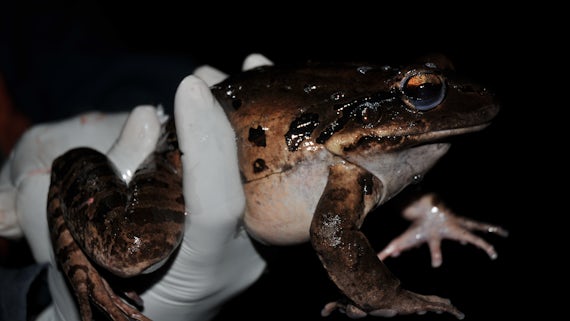Mountain chicken on the edge
3 Awst 2016

Chytrid responsible for one of fastest species declines ever recorded
Scientists battling to fight a lethal amphibian disease on two islands in Caribbean have witnessed what is believed to be one of the fastest range-wide declines ever recorded for any animal – pushing a critically endangered frog species towards the verge of extinction.
Chytridiomycosis (‘chytrid’) has already been responsible for devastating hundreds of amphibian species worldwide. Now, a team of conservation scientists from the Mountain Chicken Recovery Programme (MCRP) has gathered evidence showing that over a period of just 18 months, the disease killed more than 85 per cent of ‘mountain chicken’ frogs (Leptodactylus fallax) on the island of Dominica. Nearby Montserrat fared even worse, with its own mountain chicken population being rendered virtually extinct in the same amount of time.
MCRP partners the Zoological Society of London (ZSL), Durrell Wildlife Conservation Trust, Chester Zoo and the governments of Dominica and Montserrat worked alongside scientists from Cardiff University School of Biosciences and the University of Kent to track mountain chicken populations on both islands before, during and after the emergence of chytrid. The data they collected, published today in the journal Scientific Reports, enabled researchers to build up a real-time picture of the disease’s devastating impact on this species. As well as informing future conservation efforts, this information also raises important questions about the effectiveness of existing attempts to contain the pandemic.
Josie D’Urban Jackson, a PhD student at Cardiff University School of Biosciences who undertook the genetic analysis explains the study’s results: "The catastrophic population crash caused by the deadly fungal disease, chytrid, has considerably reduced the genetic diversity of mountain chicken frogs in Montserrat and Dominica.
However, one positive finding from the study is that the genetic diversity in the captive population is representative of the wild population, providing further support to the captive breeding of this species to save it from extinction.”
Lead author Michael Hudson, based across ZSL’s Institute of Zoology (IoZ), Durrell and the University of Kent, said: “These findings from Dominica and Montserrat provide perhaps the starkest evidence to date of the terrifying rate at which chytrid is destroying the genetic diversity of amphibian populations worldwide and driving many species towards extinction.
“While eleventh-hour emergency measures at least succeeded in safeguarding a genetically-diverse captive breeding population of mountain chickens from Monserrat in European Zoos, still we have to ask ourselves how we are unable to prevent these dramatic disease-driven declines, despite global frameworks like the Convention on Biological Diversity (CBD) aiming to ensure effective mitigation measures are in place.
“Our study demonstrates the urgent ongoing need to build mitigation capacity wherever amphibians are at risk from the global chytrid pandemic.”
One of the largest species of frog in the world, the mountain chicken is found exclusively on Dominica and Montserrat in the Eastern Caribbean. Currently classed as critically endangered by the IUCN Red List of Threatened Species, its common name derives both from its size and the fact it was traditionally eaten as food by islanders.
Read the full report here: Dynamics and genetics of a disease-driven species decline to near extinction: lessons for conservation